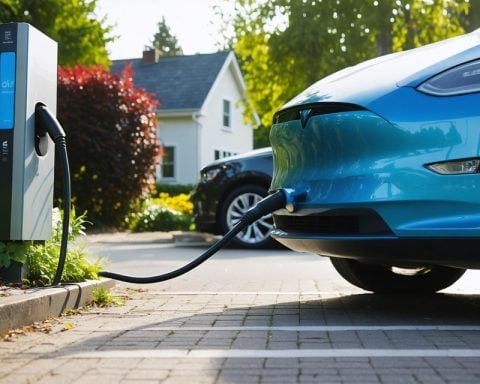- UC San Diego hosts over 500 electric vehicle chargers, highlighting California’s shift toward electric transportation.
- Students and staff increasingly depend on campus charging due to limited home infrastructure.
- California plans to electrify all new vehicles by 2035, aiming to significantly reduce emissions.
- The state’s power grid may face challenges as electric vehicles could consume one-fifth of the energy supply by 2035.
- Professor David Victor advocates for more daytime charging to leverage solar energy and reduce carbon emissions.
- The transition also suggests a need to rethink energy distribution and potential future shifts to shared autonomous fleets.
- Californians are embracing a broader sustainable future beyond just electric vehicles.
Underneath the rhythmic pulse of academia, UC San Diego hums with a quieter force—a network of over 500 electric vehicle chargers. Here, amid the concrete sprawl of a bustling campus, chargers buzz tirelessly as students and staff prepare to power their way back home. Yet this infrastructure is just the beginning of California’s daring electric vision.
The parking garages, abuzz with the hum of charging cables, are a lifeline for students like Isaiah, whose hybrid car reflects the growing shift towards electric. Isaiah represents a wave of drivers relying on campus resources due to the lack of charging capabilities at home. The scene paints a picture of an evolving transportation landscape, with UC San Diego as both a harbinger of change and a microcosm of the challenges to come.
Professor David Victor stands at the helm of this transformation, foreseeing an exponential surge in charging infrastructure as California aims to electrify all new vehicles by 2035. This shift promises to drastically cut emissions, with transportation currently the nation’s largest carbon contributor. However, the question looms: Can the existing power grid bear the load?
The California Energy Commission suggests that by 2035, electric vehicles will demand a fifth of the state’s energy. The nighttime hours, traditionally the cheapest for charging, rely on carbon-heavy sources—a paradox in a state striving for emission reductions. Victor advocates for daylight charging when solar energy is abundant, urging people to consider environmental costs over mere convenience.
As new drivers like Stella navigate this territory, adapting their routines to their vehicle’s power needs, the broader narrative becomes clear. California’s electric dream isn’t just about changing cars; it requires a reimagining of how we harness and distribute power. The future might steer us towards shared autonomous fleets, minimizing individual ownership and smoothing energy demand.
In this quiet revolution, Californians are not just charging cars; they’re charging into a sustainable future.
The Future of Charging: How California’s Universities Are Leading the Electric Vehicle Revolution
How-To Steps & Life Hacks
1. Optimize Charging Times:
Maximize the use of renewable energy by scheduling your EV charging during peak solar production, typically midday. Many modern EVs allow you to set charging times right from your smartphone. Check your EV’s manual for instructions on how to adjust charging schedules.
2. Utilize Campus Resources:
If you’re a student or staff member at a university with EV infrastructure, take full advantage of the free or discounted charging available. Connect with your campus transportation services to understand any policies or programs designed for EV owners.
3. Participate in Programs:
Join utility demand response programs. These initiatives offer incentives for car owners to charge at times when electricity demand is lower, helping to stabilize the grid. Contact your electricity provider to see what’s available in your area.
Real-World Use Cases
UC San Diego’s emphasis on charging infrastructure is part of a broader trend in higher education. Similar programs at universities are helping to pave the way for widespread EV adoption. For instance, the University of California, Berkeley, and Stanford University are also investing heavily in EV charging, contributing to the normalization of electric vehicles among young drivers.
Market Forecasts & Industry Trends
According to the California Energy Commission, the demand for electric vehicles (EVs) will continue to grow, necessitating significant expansion in charging infrastructure. Market analysts project that California will need as many as 1.2 million public and shared charging ports by 2030 to meet EV demand. This boom represents a potential goldmine for businesses investing in charging technologies.
Reviews & Comparisons
California’s public universities, through initiatives like the one at UC San Diego, often lead in implementing comprehensive green policies. The effectiveness of these implementations can vary. For example, reviews from users at UC Irvine praise its availability of high-speed chargers, while others note overcrowded facilities at peak times. The choice of provider, availability of spots, and reliability of service can affect user satisfaction significantly.
Controversies & Limitations
The rapid adoption of EVs raises significant questions about grid capacity. As noted by Professor David Victor, the existing power infrastructure will need upgrades to cope with increased load, particularly as EVs contribute to peak energy demands. Critics argue that without these upgrades, the shift to electric vehicles could strain the grid and lead to increased brownouts or outages.
Features, Specs & Pricing
California’s universities offer a mix of Level 2 and DC fast chargers. Level 2 chargers can deliver about 25 miles of range per hour of charging, whereas DC fast chargers provide up to 90 miles in 30 minutes. Charging costs vary; while some universities offer subsidized rates or free charging for students and staff, others charge a nominal fee per kWh.
Security & Sustainability
Ensuring that EV charging stations are secure and environmentally friendly is critical. Universities use renewable energy sources like on-campus solar farms to power charging stations sustainably. It’s also crucial to monitor for any potential security risks, such as unauthorized use or data breaches from connected charging networks.
Insights & Predictions
By 2035, California’s ambitious EV goals could reshape transportation infrastructure across the state significantly. Expect advancements in charging technology, like increased station availability and faster charging times. Economists predict that an upsurge in EV production could also lead to reduced vehicle costs, thereby accelerating adoption further.
Tutorials & Compatibility
For students and staff new to EVs, UC San Diego should provide workshops or tutorials on how to use EV chargers, including compatibility with different vehicle types. EV compatibility is crucial as not all chargers work with every vehicle model.
Pros & Cons Overview
Pros:
– Reduced emissions and environmental impact.
– Decreased fuel costs compared to traditional vehicles.
– Access to innovative technology and government incentives.
Cons:
– Higher upfront vehicle costs.
– Limited charging infrastructure in certain areas.
– Potential strain on existing power grids.
Actionable Recommendations
– Explore Available Incentives: Check federal, state, and local government sites for grants, tax reductions, and rebates available for EV purchases and charging installations.
– Plan Charging Ahead: Given the grid limitations, especially in areas with high EV adoption, planning your charging in advance during off-peak hours can reduce costs.
– Stay Informed: Keep up-to-date with infrastructure developments and policy changes that may affect EV ownership.
For those interested in learning more about electric vehicles and charging infrastructure, visit the California Energy Commission’s website for detailed reports and updates.













